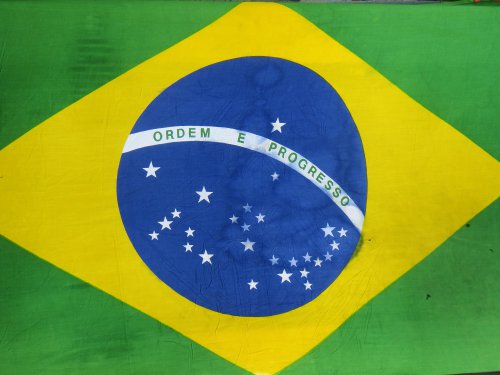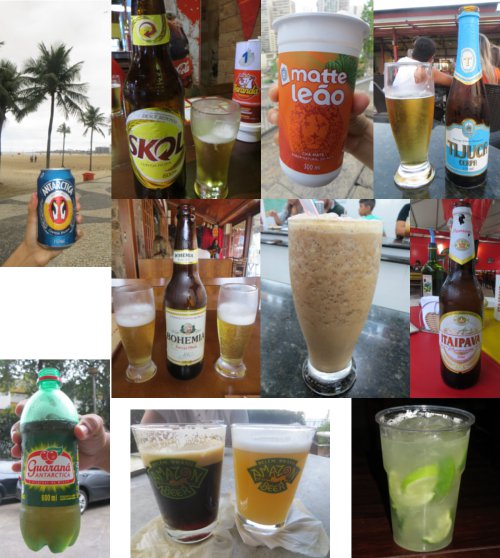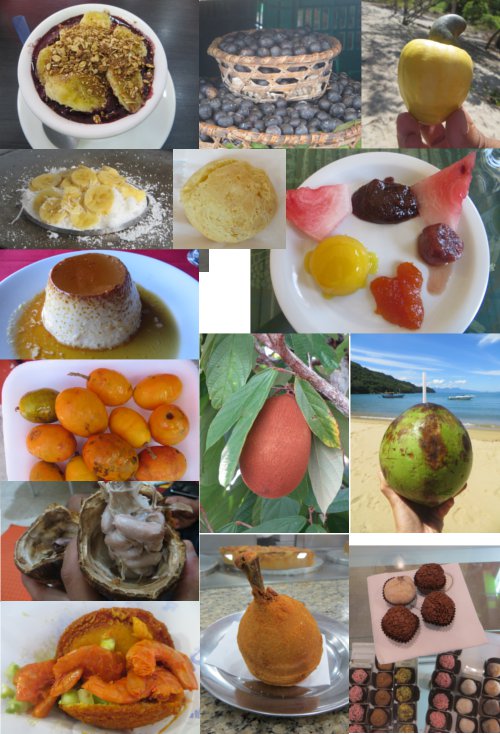Best of Brazil
We spent 67 days traveling from the south to the north of Brazil from October 16, 2015. After visiting Paraguay, we entered Brazil by foot, crossing the bridge that connects both countries over the Parana River. We completed a total of 155 hours traveling in buses, 38.5 hours by boat, and 3 hours flying. We visited several states of Brazil and made stops at Foz do Iguaçu, Bonito, São Paulo, Paraty, Ilha Grande, Rio de Janeiro, Ouro Preto, Brasilia, Lençois, Chapada Diamantina National Park, Salvador, Recife, Fortaleza, Jericoacoara, Atin, Lençois Marahenses National Park, Sao Luis, Belem, Alter do Chao, Manaus, and Tabatinga. So far, Brazil has been the country where we spent more time traveling during our world trip, and we are so glad we did it is simply amazing! Brazil is huge and with valid reasons most people say Brazil is many countries in one.

We were impacted by many aspects of this nation: its cultural diversity, music, history, architecture, cuisines, people, and natural beauty. We hope our memories could capture and make justice to all the fantastic experiences and happiness Brazil gave us. We wrote an article regarding the national parks and reserves we visited and if you are interested in nature make sure to read the article. 😉
Brazil is a multicultural society, a country where immigrants from all over the world found home, a big melting pot. Today, Brazil has about 220 indigenous groups which speak more than 180 different languages. Indigenous, Portuguese, African, Japanese, Chinese, European, Jewish, and Arab descendants as well as new waves of immigrants coming from Latin America, Africa, and Arab nations are part of this wonderful society today. Just visiting Sao Paulo, where the biggest Japanese community outside Japan live is enough to understand the diversity of this country. We learned in the Museu da Lingua Portuguesa (Museum of the Portuguese Language) that the Portuguese language spoken in Brazil has been significantly influenced by the languages of the natives of Brazil, such as Tupinamba, multiple languages brought by the Africans, such as Banto, Quicongo, Quimbundo, and Umbundo, and as well as the Spanish, Italian, German, Arab, and Japanese languages brought by other immigrants. We had a great time trying to understand and learn some words in Portuguese, a lot of times speaking Spanish helped us, but in some cases the similarities between the two idioms were misleading. Just to give you a funny example, the word borracheria. Borracheria in Portuguese means ‘Tire Repair Shop’ which comes from borracha meaning rubber. It is similar to the Spanish word ‘borrachera,’ which means: being drunk. When we first saw signs with ‘Borracheria,’ we believed Brazilians were very explicit and open about places for drinking alcohol, until we were finally told by a local what it really meant. 🙂
Brazil is the fifth largest country and the fifth most populated as well. It was declared to be the seventh best economy of the globe but also the one with the biggest gap between the wealthy and poor in Latin America. Currently, Brazil has the largest commercial cattle population in the world and the third largest pig population. Brazil is also among the countries with the highest mining potential worldwide and it is the society with more Catholics on earth.
Brazil was populated by different indigenous groups like Tupinamba and Guarani, among others, before it was rediscovered by the Portuguese navigator Pedro Alvares Cabral in 1500. Until the declaration of independence in 1822, Brazil was a colony of the Kingdom of Portugal. In 1822 the prince, son of the king of Portugal, declared independence of Brazil and became the first emperor. Brazil has been the only monarchy in the Americas. At that time Brazil’s economy was based on sugar cane and when that industry crashed, mining and large coffee plantations with slave labor force brought from Africa was introduced. Coffee was the main driver of the Brazilian economy in the 19th century and the country today is still the biggest producer and exporter of coffee in the world. During the difficult years of slavery, many Africans and African descendants escaped and formed free communities named “quilombos.” Others slaves were able to pay for their own right to freedom. Although Africans made different failed efforts to resist slavery, the abolition of slavery in Brazil did not occur until 1888, motivated by the abolitionist movement that began in 1850 and the British prohibition to slave trafficking. Brazil was the last country in the Americas to abolish slavery. With the intention of whitening Brazil’s population, the Brazilian empire fomented the migration of European workers. In November 15, 1889 the imperial period ended in a peaceful way and the Republic, with profound inequalities and exclusions, started. After the abolition of slavery, the need of manpower for farming increased and Brazil began to open its doors to Chinese and Japanese immigrants. The Museu Historico da Imigracão Japonesa (Historic Museum of Japanese Immigration) explained to us that it was thanks to the different waves of Japanese immigrants that arrived from 1908 that the agriculture of this country was further developed and diversified into several products. However, with a trend towards urbanization, the number of Japanese farmers diminished and their involvement in other professions increased. The inclusion of determined groups in the democratic process of Brazil took place throughout the 20th century: women’s right to vote in 1934 and illiterate person’s right to vote in 1988. This is how Brazil became what it is today, an icon, a unique nation, a dream destination, a diverse and multicultural society that gave birth to distinguished people of their time like writer Jorge Amado, the architect Oscar Niemeyer, the soccer player Pele, or the unique ceramics of Francisco Brennand. From whatever angle you wish to look at it, Brazil has plenty of reasons to fascinate many from all over the world!
We also learned in many museums we visited about the terrible history of the 3.6 to 5 million African slaves brought to Brazil and the long lasting consequences of this cycle of abuse in their society today. It is estimated that Brazil received 40% of all the African slaves brought into the Americas. 20% of the African slaves died on their way to the Americas. For nearly four hundred years, Brazilian slavery consumed many generations of Africans. The slave population was characterized by a high rate of infant mortality and short life expectancy, both resulting from the terrible conditions in which they were forced to live. African slaves worked under inhumane conditions an average of 16 hours per day, their life expectancy was only 12 years as a slave in Brazil. Women were raped and used to satisfy the sexual impulses of their owners. Sexuality amongst slaves was allowed only for reproduction, never to form a family. We were impacted by the tales of African leaders like Chico Rey in Ouro Preto and Zumba in Recife. Chico Rey was a great African king who him as well as his tribe were brought as slaves. He bought his freedom and helped many others to do the same during the times of gold mining in Ouro Preto. Zumba was an African slave that promoted the escape to liberty and the formation of the quilombos. In honor of him, the month of November in which he was assassinated by the Portuguese colony, Brazilians celebrate Black Consciousness. Today, the black and mixed race population represents 70% and 10% of the poverty in Brazil, respectively. In the cities, two-thirds of the youth assassinated between the ages of 15 and 18 years old are black. In the universities only 2% are represented by black ethnic students and of 5,400 professors less than 10 are black.
When we were in Brazil strong protests and a generalized lack of satisfaction with the present government was in the air. All Brazilians we asked about the situation expressed feeling tired with the political corruption of their country and did not understand where their almost 30% of taxes is being spent. Citizens seem to be tired with the policies that continue benefiting the interest of the wealthy and the banks in a so called “socialist government.” They seem tired of the painful contrast between the opulent buildings right in front of Copacabana or Ipanema beaches and the favelas of the less privileged right behind. In the same tone Brazilians are very upset and cannot justify the amount of money that is being spend for the coming 2016 Olympic Games in Rio de Janeiro and the previous millions in expenses of the World Cup of 2014. Some were asking their current president Dilma Rousseff to renounce and many referred feeling disbelief regarding her recent reelection, as she won just with the 51% of the votes. There was a movement to try to impeach the president and on the other side of the spectrum many other felt this was a political strategy used by other corrupted politicians to deviate attention over their own scandals of corruption by blaming it all on the president. Regardless of their political and financial crisis, we found throughout the country very well designed museums which were in their majority guided and free of entrance. We also admired and enjoyed clean bathrooms free of charge everywhere we went in Brazil. We noticed across the country a strong effort towards recycling. The cities have different trash containers for organic, plastic, and paper waste. We were impressed with the infrastructure and development of Brazil: cities with efficient and comprehensive public transportation. Brazilian music and happy spirited-people were felt throughout the country. Brazilians treated us with so much kindness and joy, even if we could not speak their language, they always wanted to talk, smile, help, and make us feel welcome. We felt the warmth and hospitality of Brazilian people even in big cities, such as São Paulo. We love them!
When our time to leave Brazil was inevitable because we had promised we will be with our families for Christmas and New Year’s in Colombia, we faced it with great nostalgia. The happiness we experienced in this wonderful country goes beyond words. The rest of Brazil we have not seen could take us a lifetime. We added Brazil to the list of countries we could see ourselves living in and we cannot wait to be back… Thanks Brazil for everything you gave us!!
Below are other great things we enjoyed about Brazil:
Food and Drinks
Pão de Queijo: cheese and manioc (cassava) bread
Açai Juice: amazon fruit
Coconut Water
Pintado Fish
Tilapia Fish
Bacu Fish
Capirinha: brazilian cocktail
Japanese Food
Guarana Antartica Soft Drink
Açai with granola and fruit
Coxinha: chicken dumpling
Mortadela Sandwich
Pizza
Brigadeiro: chocolates
Skol Beer
Bohemia Beer
Fried Shrimp
Itaipava Beer
Seafood Moqueca: fish, shrimp, squid, octopus, and mussels slowly cooked with onions, garlic, tomatoes, and pepper
Pirão: gravy made with fish stew
Cold Mate Drinks: tea-like drink
Tapioca with banana, coconut, and nutella: similar to a crepe, but made with manioc (cassava)
Farofa: manioc (cassava) flour fried with spices and other ingredients
Feijoada: pork and bean stew
Bahian Food: seafood, palm oil and coconut milk based recipes, tropical fruit based desserts, etc.
Acaraje: bean paste fried in palm oil, stuffed with shrimp, fish paste, and vegetables
Bavaria Beer
Axe: cachaça (brazilian liquor) with herbs
Tamarind
Seriguela: hog plum
Acerola: red, cherry-like, Amazon fruit
Caja: small, golden, juicy, tropical fruit
Caju: cashew apple
Pudim: milk custard pudding
Grilled Shrimp
Caipifrutas: similar to caipirinha, but with other fruit instead of lime
Tacaca: manioc (cassava) soup with jambu (local herb) and shrimp
Amazon Beer
Cupuaçu: tropical fruit, cousin of cocoa
Graviola: soursop
Vatapa: cream made with coconut milk, palm oil, and shrimp
Maniçoba: manioc (cassava) leaves seasoned with bacon, meat, blood sausage, and pork
BomBom: chocolates filled with local fruit and/or nuts
Tapioca with Tucuma (a palm fruit) and Cheese
Beef Tongue in Tomato Sauce
Amazon Fish
Piranhas



Favorite Sights and Activities
Enjoying all the Natural Wonders of Brazil, including Parque Nacional Lençois Marenheses, Bonito, Iguaçu Waterfalls, and the Amazon Jungle Tour, Just to Name a Few
Appreciating the Numerous Friendly People we came in Contact with throughout the Country
Munching on Scrumptious Food and Listening to Music as Diverse as the Brazilian People
Starring in Awe at the Mixture of the Natural and Urban Setting of Rio de Janeiro
Walking and Taking Great Public Transport throughout the Culturally Diverse, Big Metropolis of São Paulo
Admiring the Beautiful Churches and Colonial Architecture in the cities of Ouro Preto, Salvador, Paraty, and Olinda
Surprised by the Modern Architecture built over 55 years ago in Brasilia
People
Gorqui: from Ecuador, met during our visit to the Parque Nacional do Iguaçu.
Federico and Juliana: from Argentina and Brazil, Federico worked in a travel agency in Bonito where he kindly helped us book tours and also were able to go out for drinks.
Joselito and Dolce: from Brazil, a couple we met in our hostel in Bonito.
Rubens: from Brazil, our CouchSurfing host in Sao Paulo.
William: from Colombia, met during a walking tour of Sao Paulo.
Eunise: from Brazil, Rubens’ mother.
Lennon: from Brazil, originally met in Bolivia and were able to get together in Sao Paulo.
Henry and Mona: from Chile, met while CouchSurfing with Rubens in Sao Paulo.
Lauro and Melissa: from Brazil, our Couchsurfing hosts in Rio de Janeiro.
Thiago and Daniel: from Brazil, our CouchSurfing host in Ouro Preto.
Achilles and family (Miguel, Adelza, and Katielle): from Brazil, our CouchSurfing hosts in Brasilia.
Emerson: from Brazil, met while camping in Lençois.
Albert: from Spain, met while camping in Lençois.
- Katyl: from Brazil, our CouchSurfing host in Salvador.
Alex: from Brazil, met in a restaurant in Salvador.
Aron: from the Netherlands, met while CouchSurfing with the same host in Recife.
Juliana: from Brazil, met while CouchSurfing with the same host in Recife.
João: from Brazil, our CouchSurfing host in Recife.
Paulo: from Brazil, our CouchSurfing host in Fortaleza.
Roberto: from Brazil, met during a tour in Jericoacoara.
Annick: from Switzerland, met during our transportation to Atins and invited us to see the sand dunes with water in Parque Nacional Lençois Marenheses.
Ronaldo and Mayara: from Brazil, our CouchSurfing hosts in Sao Luis.
Lucas and family (Luis Carlos, Juliana, Bruno): from Brazil, our CouchSurfing host in Belem.
Leo: from Brazil, a friend of Lucas’ that we met in Belem.
Patricia: from Switzerland, met during our Amazon ferry from Belem to Santarem.
Phillip and Jen: from the UK, met during our tour to the Amazon.
Felipe: from Chile, met during our tour to the Amazon.
Animals Viewed
Coatis
Monkeys
Tapir
Macaw
Various Types of Fish
Armadillo
Various Types of Birds
Capybara
Sloth
Gray and Pink Dolphins
River Otters
Piranhas
Caimans
Tarantulas

Native Words
Jacare = Caiman
Sucuri = Anaconda
Obrigado/a = Thank you
Rodoviario = Bus Station
Morango = Strawberry
Abacaxi = Pineapple
Crianzas = Children
Cha = Tea
Cachoeira = Waterfall
Legal = Cool
Abacate = Avocado
Ficar = To stay
Ligar = To Call
Perto = Close
Longe = Far
Amanha = Tomorrow
Manha = Morning
Preto = Black
Amarelo = Yellow
Vermelho = Red
Cerveja = Beer
Prata Feito = Dish of the Day (literally: Dish Pre-made)
Almoço = Lunch
Jantar = Dinner
Falar = To Talk
Hoje = Today
